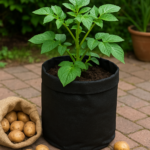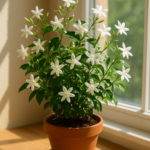Imagine a miniature desert rose—only it’s spiny, silvery, and crowned with delicate pink blossoms. That’s Mammillaria senilis for you: a pint-sized powerhouse of charm that fits in the palm of your hand yet packs more personality than many larger houseplants. Native to the highlands of central Mexico, this little globular cactus endures scorching sun by day and brisk, cool nights, developing a dense “fuzz” of radial spines that both protect and decorate its emerald-green body. Come spring, it rewards patient growers with a halo of tiny, funnel-shaped flowers that range from soft white to blush pink, transforming an otherwise unassuming sphere into a floral crown.
What makes Mammillaria senilis so appealing? For starters, its compact size and slow growth rate make it perfect for windowsills, terrariums, and miniature rock gardens. It’s forgiving of the occasional watering slip-up, thriving on neglect more than pampering—a dream for busy plant lovers or beginners. Plus, its ability to produce offsets means you can share baby cacti with friends or expand your own collection effortlessly. In this guide, we’ll dive into everything you need to know—from soil mix recipes and watering schedules to propagation tricks and pest control—so you can cultivate a healthy, happy Mammillaria senilis that dazzles year after year.
What Is Mammillaria senilis?
Mammillaria senilis is a petite, globular cactus species cherished for its dense web of spines and charming ring of flowers. Often called the “Old Man Cactus” (though several Mammillaria share that nickname), it stands out with fine radial spines that create a fuzzy, silvery appearance. This little desert jewel is perfect for windowsills, terrariums, and rock gardens.
Why Grow This Charming Cactus?

Why choose Mammillaria senilis over any other succulent? Picture a miniature snowball blooming with tiny pink or white flowers—it’s a conversation starter! Plus, it’s forgiving for beginners, thriving with minimal fuss. If you crave low‐maintenance greenery with high aesthetic payoff, this cactus is your new best friend.
Taxonomy and Natural Habitat
Family and Genus Overview
Mammillaria senilis belongs to the Cactaceae family, one of the most diverse families of succulents. Within this family, the Mammillaria genus boasts over 200 species, all sharing the hallmark tubercles (nipple-like projections) instead of ribs.
The Mammillaria Genus at a Glance
- Distribution: Predominantly Mexico, with some species in the southern USA, Caribbean, and Central America.
- Key Features: Tubercles, areoles at tubercle tips, radial and central spines, vibrant flowers.
Native Range and Ecology
M. senilis is native to the central highlands of Mexico, flourishing at altitudes between 1,500 and 2,000 meters. Here, it endures blazing sun by day and cool nights—an extreme fluctuation that toughens it up for home cultivation.
Climate and Soil Conditions in the Wild
In its habitat, rainfall is sparse, often under 300 mm annually. Soils are rocky, gritty, and fast-draining, loaded with minerals. Mimicking these conditions is key: think gritty cactus mix, bright sun, and minimal water.
Morphological Characteristics

Stem and Growth Form
Mammillaria senilis typically grows as solitary spheres, up to 8 cm in diameter. Over time, older plants may form small clusters of offsets, creating a delightful “pincushion” effect.
Areoles, Spines, and Tubercles
Each tubercle ends in an areole bearing 20–30 radial spines, slender and hair-like, white to silvery. Central spines may be slightly thicker and darker—giving texture contrast. This spine network defends against herbivores and shades the stem.
Flower and Fruit Description
In spring to early summer, a crown of funnel-shaped flowers appears around the apex. Colors range from pale pink to crisp white, often with a darker midstripe. Post-pollination, they yield small, red to orange berries—an enticing bonus for pollinators and seed collectors.
Blooming Season and Pollination
Expect blooms when daylight hours ramp up and temperatures hover between 20–30 °C. Bees and small insects do the honors in nature; at home, gentle hand-pollination with a soft brush can boost fruit set.
Cultivation Requirements
Light and Temperature Needs
Place your Mammillaria in bright, indirect light to partial sun. A south- or west-facing window is ideal. In summer, some direct morning sun mimics its native habitat, but shield from scorching afternoon rays.
Soil Mix and Drainage Tips
Use a specialized cactus mix or DIY blend:
- 50% coarse sand or perlite
- 30% regular potting soil
- 20% fine gravel or pumice
Good drainage is non-negotiable—sitting roots in moisture spells rot.
Watering Schedule
- Growing Season (Spring–Summer): Water thoroughly when the top 2 cm of soil is dry.
- Dormant Season (Fall–Winter): Reduce to once a month or less.
Seasonal Adjustments
In winter, cooler temps (around 10–12 °C) and minimal water mimic desert winter, promoting spring blooms.
Propagation Techniques

Seed Propagation
Want to start from scratch? Seeds are tiny but rewarding.
Step-by-Step Seed Sowing Guide
- Sterilize seed tray and tools.
- Fill tray with damp cactus mix.
- Scatter seeds on surface; do not bury.
- Cover with clear plastic or glass to maintain humidity.
- Place in bright, indirect light at ~24 °C.
- Ventilate daily to prevent mold.
- Transplant seedlings when 1 cm tall.
Offset Division
Mature plants often form offsets (“pups”)—nature’s clones.
How to Separate and Plant Offsets
- Gently remove parent plant from pot.
- Locate offsets with small roots.
- Twist or cut with sterile blade.
- Callus the cut ends for a few days.
- Plant in fresh cactus mix; resume light watering after a week.
Common Pests and Diseases
Identifying Mealybugs and Spider Mites
- Mealybugs: White cottony clusters in areoles.
- Spider Mites: Fine webbing, tiny red dots under spines.
Treatment Options and Prevention
- Isolate infected plants.
- Wipe spines with alcohol swab.
- Neem oil or insecticidal soap sprays monthly.
Fungal Issues and Root Rot
Overwatering invites root rot—brown, mushy roots and yellowing stems.
Best Practices for Fungus Control
- Use sterile pots and fresh soil.
- Ensure drainage via holes and gravel layer.
- Treat early with fungicide drench.
Landscaping and Decorative Uses
Container Gardening Ideas
These cacti rock in shallow terracotta pots or decorative ceramic bowls. Try grouping varied Mammillaria for textural contrast.
Pairing with Other Succulents
Synergize with Echeveria rosettes or Haworthia spikes—contrasting shapes and bloom times make a dynamic display.
Rock Gardens and Xeriscaping
In outdoor rock gardens (USDA zones 9–11), plant in crevices where runoff drains quickly. Their petite size fits perfectly among stones.
Benefits and Cultural Significance
Medicinal and Ethnobotanical Uses
While not a major medicinal species, some traditional uses report poultices from related Mammillaria for minor skin ailments. Always research safety before topical use!
Symbolism in Succulent Enthusiast Communities
Mammillaria senilis symbolizes resilience—thriving where few plants can. Enthusiasts prize it for its “aged” appearance and winter blooms, celebrating patience and endurance.
Troubleshooting Common Problems

Yellowing or Softening of Stems
- Cause: Overwatering or poor drainage.
- Fix: Repot in fresh mix, cut away rotten tissue, reduce watering.
Lack of Flowering
- Cause: Insufficient light or cool winter period not pronounced.
- Fix: Increase bright light, drop night temperature to 10–12 °C for 6–8 weeks in winter.
Expert Tips for Thriving Plants
Fertilization Recommendations
Feed with a balanced 10-10-10 cactus fertilizer diluted to half strength, once monthly during active growth. Skip feeding in dormancy.
Seasonal Care Calendar
| Season | Light | Watering | Temperature | Fertilizer |
|---|---|---|---|---|
| Spring | Bright indirect | Moderate | 20–25 °C | Monthly |
| Summer | Partial direct AM | Moderate | 25–30 °C | Monthly |
| Autumn | Bright indirect | Reduced | 15–20 °C | None |
| Winter | Bright indirect | Minimal | 10–12 °C | None |
Conclusion
Mammillaria senilis packs desert drama into a tiny sphere—its silvery spines, seasonal blooms, and easy-care nature make it a superstar for both newbie and veteran growers. By mimicking its native Mexican highland conditions—gritty soil, bright light, and a tastefully minimal watering routine—you’ll be rewarded with healthy growth, charming offsets, and that magical ring of flowers each spring. So go ahead: give your space a touch of arid elegance with this little cactus wonder!
Frequently Asked Questions
1. How often should I repot Mammillaria senilis?
Repot every 2–3 years in spring, or when roots fill the pot, to refresh soil and check for rot.
2. Can Mammillaria senilis tolerate frost?
No, it’s frost-sensitive. Keep above 5 °C or bring indoors if night temperatures drop near freezing.
3. What causes brown spots on the cactus tubercles?
Brown spots often signal sunburn (too much direct sun) or fungal infection from overwatering. Adjust light and moisture accordingly.
4. How long does it take to bloom from seed?
Typically 2–3 years under optimal conditions—good light, temperature swings, and patient care.
5. Is Mammillaria senilis toxic to pets?
No major toxins are reported, but spines can injure curious pets. Keep out of reach.







